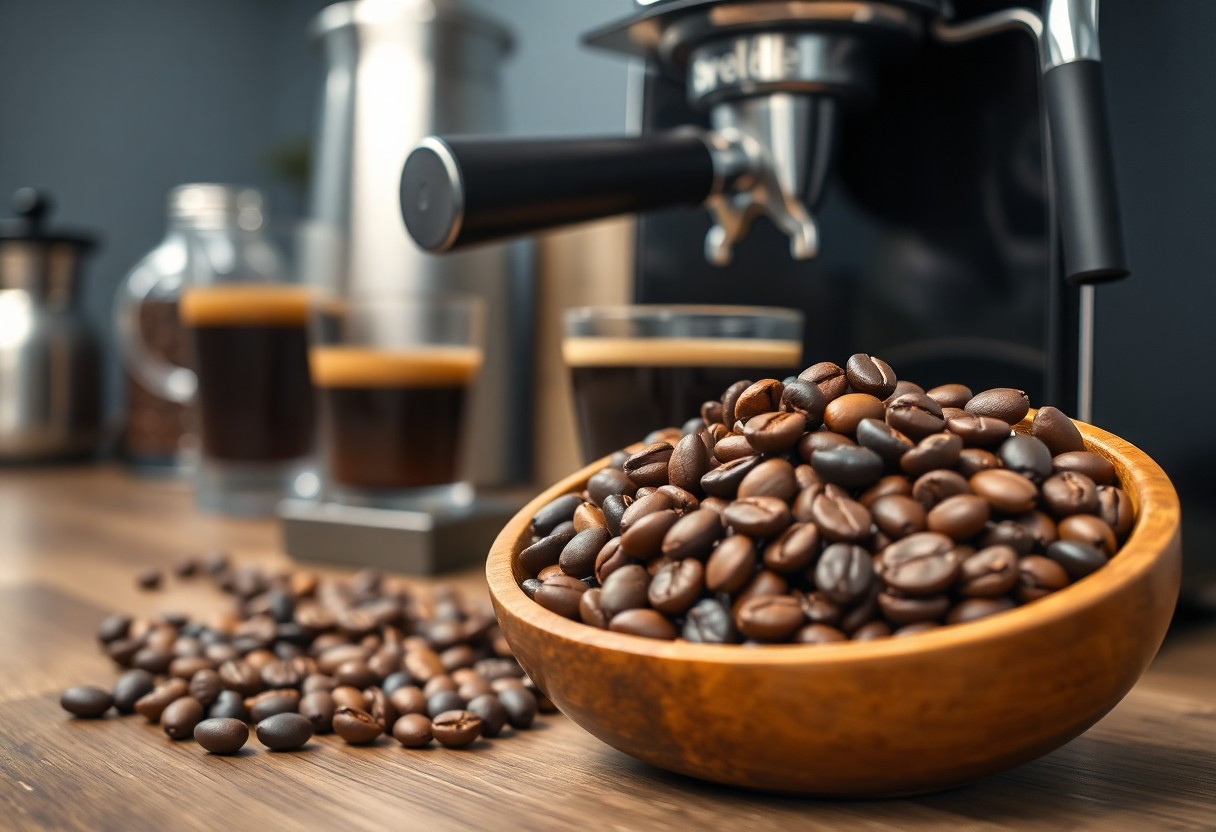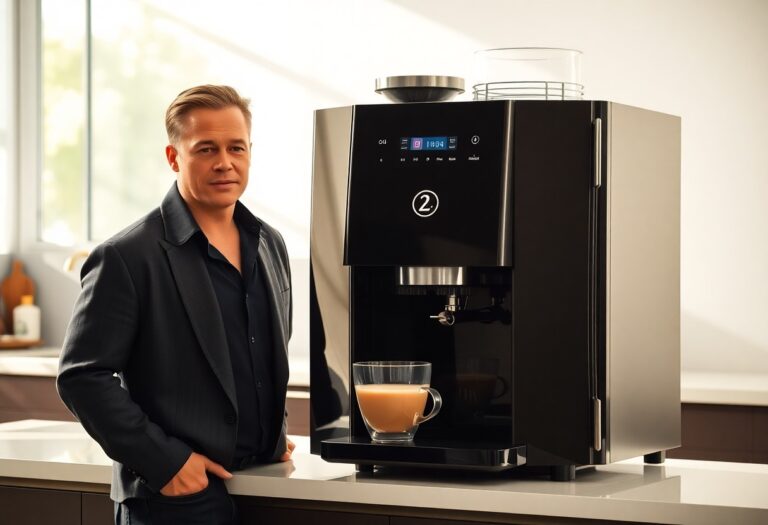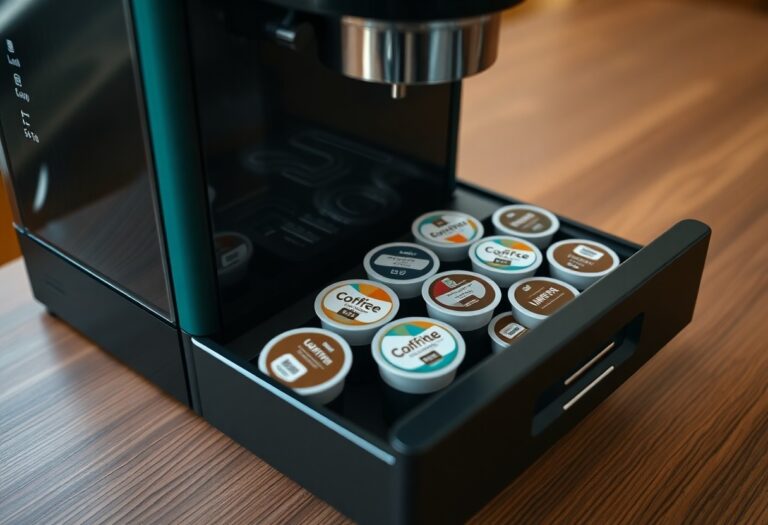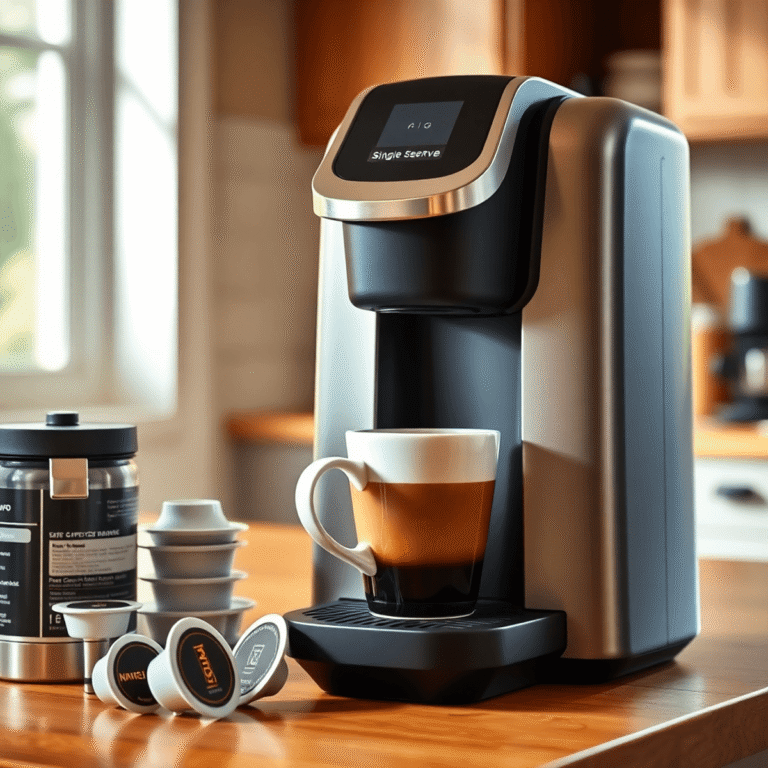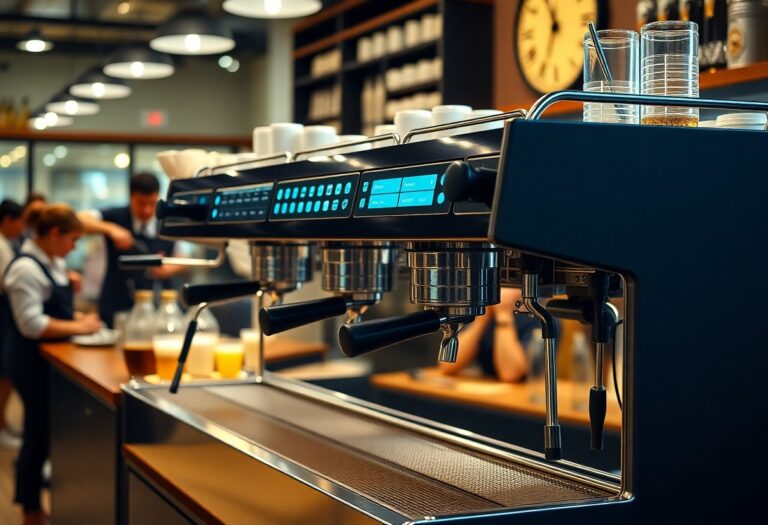What Coffee Beans to Use for a Breville Espresso Machine
It’s vital to choose the right coffee beans for your Breville espresso machine to get the best flavor and aroma. Specialty-grade beans are often recommended for their rich taste and quality, while medium to dark roasts tend to produce the most balanced and bold espresso. You should also consider the coffee’s origin and blend to suit your personal palate. By selecting the best beans, you can enjoy an espresso that highlights your machine’s capabilities and enhances your coffee experience.
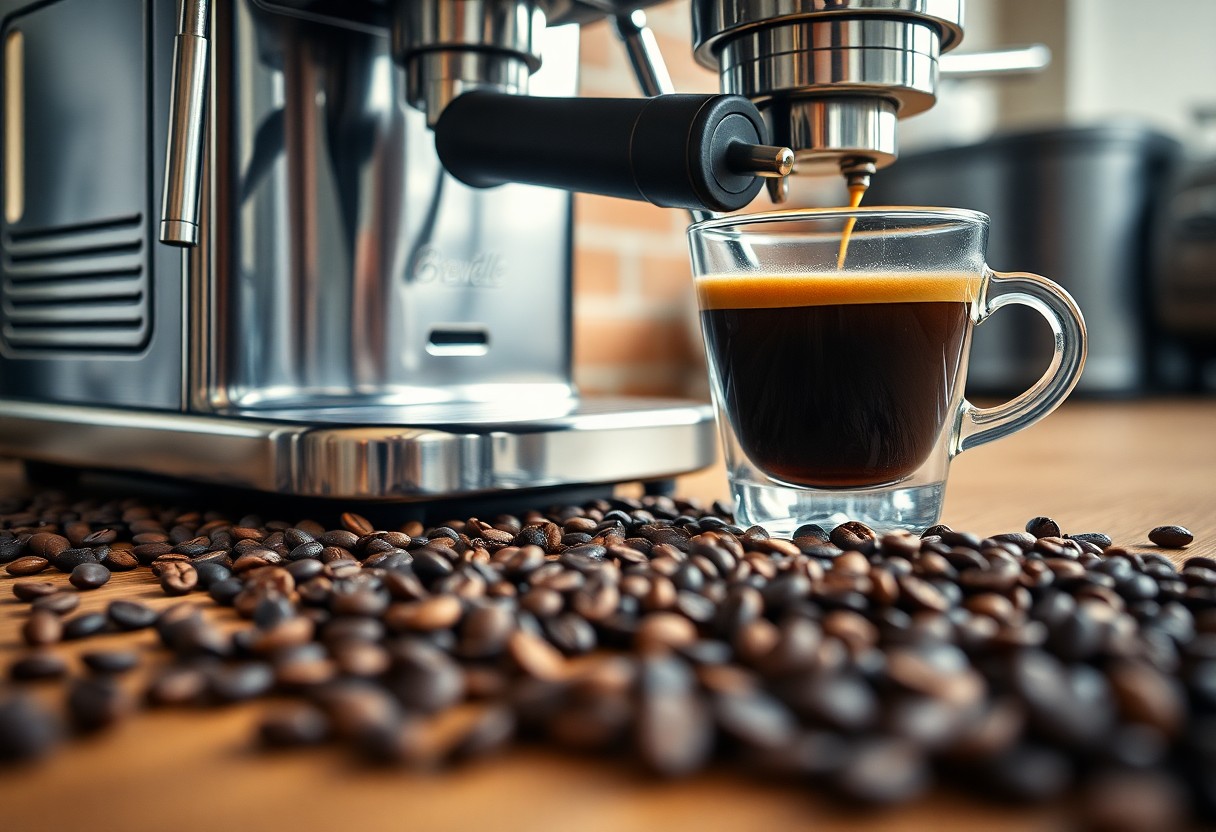
Key Takeaways:
- Choose high-quality Arabica beans for a smoother, more complex flavor profile in your espresso.
- Dark roasts tend to produce a richer crema, while medium roasts offer a balanced acidity and flavor.
- Freshly roasted beans are necessary; aim to use beans that have been roasted within the last two weeks for the best flavor.
- Experiment with different bean origins to discover unique flavor notes, such as chocolatey, fruity, or nutty characteristics.
- Grind size is important; for espresso, a fine grind creates optimal extraction, enhancing the coffee’s flavor and aroma.
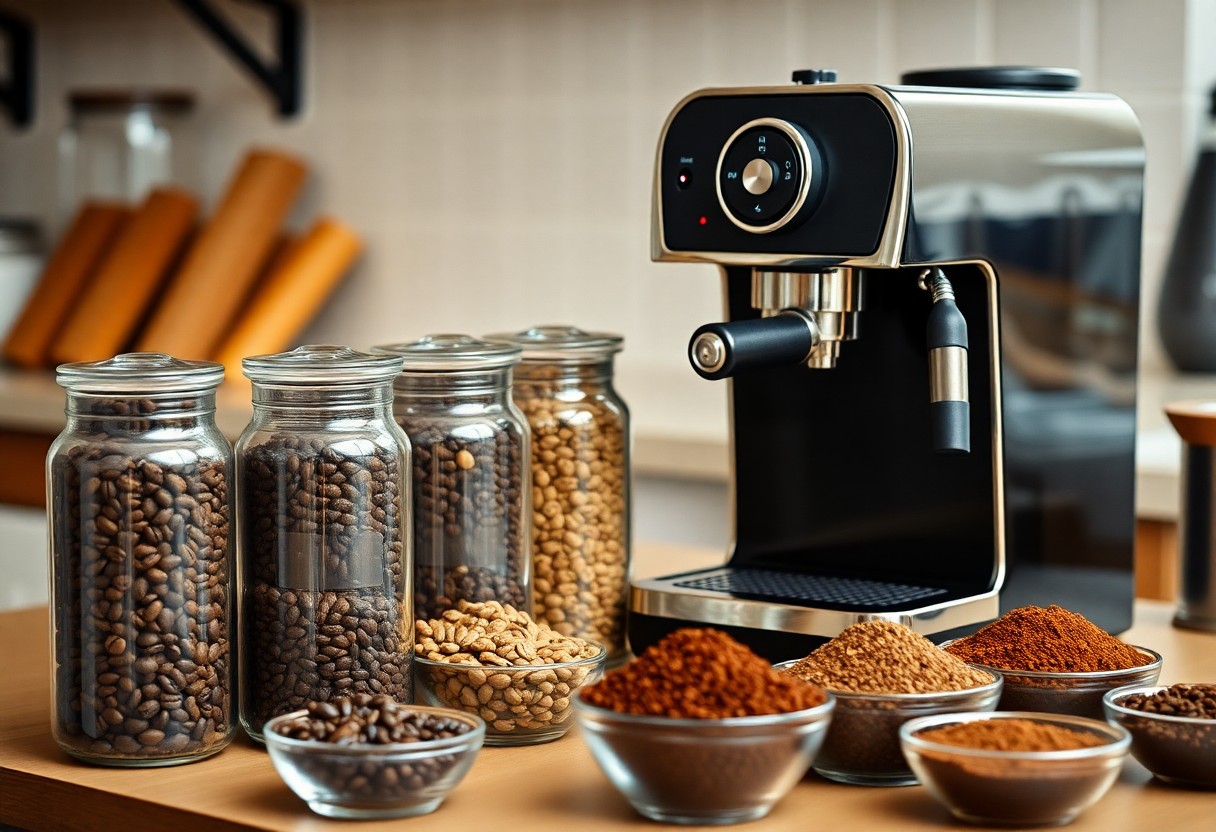
Choosing the Right Roast Profile for Espresso
Selecting the ideal roast profile greatly influences your espresso experience. Whether you prefer a light, medium, or dark roast impacts the flavor, aroma, and overall balance. Each profile brings unique characteristics to the cup; thus, experimenting with various roasting levels helps you find your perfect match. Ultimately, it’s about aligning the roast with your taste preferences and the type of espresso you aim to create.
Understanding Flavor Notes: Light, Medium, and Dark Roasts
Flavor notes vary significantly across roast levels. Light roasts often showcase fruity, floral, and acidic notes, making them vibrant and tangy. Medium roasts provide a balance, merging sweetness with slight acidity. Dark roasts, on the other hand, deliver bold, deep flavors with chocolatey, nutty, and smoky undertones, masking some of the bean’s inherent characteristics. Depending on your palate, each roast offers a distinct approach to espresso.
The Impact of Roast Level on Extraction and Crema
Roast levels affect not just taste but also extraction and crema formation. Lighter roasts typically have less oil, leading to a thicker crema, while darker roasts’ oils can enhance crema but might overshadow the more delicate flavors. This balance affects extraction time and pressure, influencing the final shot’s quality.
The extraction process relies on the roast’s chemical composition. Lighter roasts often require slightly longer extraction times to unlock their full flavor potential, while darker roasts can extract quickly due to their solubility and increased oils. These oils contribute directly to the crema’s quality, offering a rich texture but also introducing bitterness if over-extracted. Striking the right balance between your roast choice and extraction technique ensures that you achieve the perfect shot with enticing crema and vibrant flavor.
The Role of Bean Origin in Espresso Quality
The origin of your coffee beans plays a significant role in the quality of your espresso. Beans sourced from different regions exhibit distinct flavor profiles, influenced by factors such as climate, terrain, and cultivation methods. For an in-depth exploration of how to maximize your espresso experience, check out How to get the most out of the Sage/Breville Barista Express. Understanding these nuances can help you select the right beans for your taste preferences, enhancing your espresso enjoyment.
Single-Origin vs. Blends: Pros and Cons
Deciding between single-origin beans and blends is important for creating your ideal espresso flavor. Here’s a quick overview of the pros and cons:
| Single-Origin | Blends |
| Unique flavor profile | Balanced flavor complexity |
| Specific terroir characteristics | Consistency in taste |
| Usually higher quality | Cost-effective options |
| Great for specialty brews | Customizable combinations |
| Less versatility | Potential for lower-quality beans |
| Seasonal availability | Year-round availability |
| Limited roasting options | Variety of roasting profiles |
| Unique stories behind each origin | Blending expertise |
| Can be pricier | Often more affordable |
Notable Growing Regions and Their Flavor Profiles
Each coffee-growing region offers distinct flavors that can elevate your espresso experience significantly. For instance, Colombian coffee is often characterized by its smooth, balanced taste with notes of caramel and nutty undertones. Ethiopian beans, on the other hand, can present fruity or floral flavors, providing a vibrant espresso shot. Brazilian coffee tends to deliver a chocolatey and sweet profile, while Costa Rican beans are known for their bright acidity and crisp finish. Exploring these regional characteristics will enhance your overall knowledge and assist you in selecting the perfect beans for your Breville espresso machine.
The Importance of Freshness in Coffee Beans
The flavor and aroma of your espresso hinge significantly on the freshness of the coffee beans you use. As beans age, they lose crucial oils and volatile compounds that contribute to their rich flavor profile. A freshly roasted bean provides a vibrant taste experience, enhancing your espresso. For the best results, aim to use your beans within three to four weeks of roasting to capture their optimal flavor and aroma quality.
Why Freshly Roasted Beans Matter
Coffee beans start to oxidize and lose their flavor as soon as they are roasted. Freshly roasted beans offer the most flavor complexity and aromatic qualities, which are crucial for a truly remarkable espresso. When you use beans that are just a few days old, you can expect rich crema and a well-balanced shot, as opposed to a flat and dull coffee experience with stale beans.
How to Store Beans for Optimal Freshness
Protect your coffee beans from exposure to light, heat, moisture, and air to maintain their freshness. Store them in an airtight container in a cool, dark place, such as a pantry or cabinet. Avoid keeping them in the freezer, as moisture can affect the beans during thawing. Aim to buy beans in small quantities that you can consume within a couple of weeks, ensuring that you always have fresh beans ready for that perfect espresso shot.
Utilizing specific storage techniques can greatly extend the lifespan of your coffee beans. Consider using vacuum-sealed containers or specialized coffee storage canisters with CO2 valves. This will help minimize exposure to air while allowing gases produced by the beans to escape. Additionally, keeping your beans away from kitchen appliances that generate heat will ensure they remain in prime condition longer. By adopting these methods, you enhance both the flavor and freshness of your brew, offering a consistently delightful espresso experience.
Grinding Techniques for Optimal Espresso
Your method of grinding beans can elevate or diminish your espresso experience. Precision in grind size and consistency significantly influences the extraction process, allowing water to interact with the coffee grounds effectively. A Breville Espresso Machine thrives on finely ground beans, typically requiring a range from fine to extra-fine. Experimenting with your grinder settings will help you lock in the perfect taste and ensure you maximize your machine’s capabilities for the best crema and flavor profile.
Finding the Right Grind Size for Your Breville Machine
The perfect grind size for your Breville espresso machine is often a fine powder, resembling table salt. Adjust your grinder until you achieve a texture that allows for optimal extraction within 25-30 seconds. If the shot pulls too quickly, you may need a finer grind, while a shot that takes too long may call for a coarser grind. By dialing in the right size, you can enhance both the aroma and flavor of your espresso.
The Role of Grind Consistency in Extraction
Uniformity in grind size plays a vital role in espresso extraction. Inconsistent grounds lead to uneven contact with water, resulting in over-extraction and under-extraction in various areas within the coffee puck. To achieve the rich flavor and velvety crema expected from a quality espresso, maintain a consistent grind by using a burr grinder rather than a blade grinder, ensuring each particle is similar in size.
Grind consistency affects how the water interacts with the coffee, impacting the extraction rate. For instance, finer particles can clog the flow of water, leading to over-extraction in those areas, while larger particles may allow water to pass through too quickly, causing under-extraction. The ideal situation in brewing espresso is to extract flavors evenly, producing a balanced cup that showcases the beans’ unique characteristics. A burr grinder achieves this consistency, providing a uniformity that is important for excellent espresso quality.
Experimenting with Different Beans: A Guide for Enthusiasts
Exploration in coffee bean selection can radically shift your espresso experience. You might start with familiar blends but venturing into single-origin beans or unique flavor profiles can lead to delightful surprises. Consider trying beans from various regions, such as floral Ethiopian Yirgacheffe or earthy Sumatran Mandheling, each offering distinct taste characteristics. Each batch tells its own story, so keep adjusting your selection based on your evolving palate and preferences.
Creating Customized Espresso Profiles
Tailoring espresso profiles to suit your taste can yield exceptional results. By adjusting various factors, such as grind size, water temperature, and extraction time, you can enhance specific flavor notes in your chosen beans. Documenting these adjustments will help you replicate and refine your favorite profiles, transforming you into your own barista.
Learning Through Tasting: Developing Your Palate
Engaging in structured tasting sessions is a worthwhile endeavor. As you sample different beans, take notes on aroma, flavor, acidity, and body. This practice helps you differentiate subtleties among various profiles and fosters a deeper appreciation for coffee. Over time, you’ll find that recognizing these characteristics in beans becomes more intuitive, enhancing your overall espresso experience.
Participating in cupping sessions or tastings with fellow coffee enthusiasts can significantly hone your palate. You’ll be exposed to a wide range of flavor profiles and preparation methods that deepen your coffee knowledge. As you taste, focus on identifying what you like or dislike in various coffees—this personal insight will guide your future selections. Engaging with knowledgeable baristas and seeking out specialty coffee shops can provide enriching perspectives and recommendations on beans that align with your tastes, helping you craft the perfect espresso shot.
Final Words
Upon reflecting, choosing the right coffee beans for your Breville Espresso Machine can elevate your espresso experience significantly. You should focus on fresh, high-quality beans that suit your taste preference, whether that be single-origin or blends. Experimenting with different roast levels allows you to find your unique balance. For a deeper investigate achieving the perfect espresso, check out the Breville Barista Express Guide: Perfect Espresso Every Time. Your espresso journey will be well worth every sip!
FAQ
Q: What type of coffee beans should I use for my Breville espresso machine?
A: For your Breville espresso machine, it’s best to use high-quality Arabica coffee beans, as they yield a rich flavor profile with pleasant acidity. Look for beans labeled as espresso roast or medium roast for balanced taste. Dark roasts can also work well, but they may produce a stronger bitterness. It’s necessary to choose fresh beans, ideally roasted within the last few weeks.
Q: How important is the grind size of coffee for espresso?
A: Grind size is a vital factor for achieving the perfect espresso shot. For a Breville espresso machine, you should use a fine grind, which allows for proper extraction during the brewing process. If the grind is too coarse, the water will flow through too quickly, resulting in a weak shot. Conversely, if it’s too fine, it can lead to over-extraction and a bitter taste. Experimenting with grind size will help you find the optimal setting for your taste preference.
Q: Should I use pre-ground coffee or whole beans in my Breville espresso machine?
A: While you can use pre-ground coffee, it’s highly recommended to opt for whole beans. Grinding your beans just before brewing will preserve their freshness and flavor. A burr grinder is ideal for achieving a consistent grind size, which is necessary for making quality espresso. If convenience is a priority, you may choose pre-ground coffee occasionally, but be aware that it may not provide the same level of flavor and aroma as freshly ground beans.
Q: Can flavored coffee beans be used in a Breville espresso machine?
A: While you can use flavored coffee beans in your Breville espresso machine, they may not produce the same rich espresso experience as traditional coffee beans. Flavored coffee often has oils that can build up in your machine or alter the taste of your espresso shots. If you enjoy flavored coffee, consider using them as a secondary option or blending them with regular beans to achieve a balanced flavor without compromising the necessary espresso quality.
Q: How do I choose the right roast profile for my espresso?
A: Choosing the right roast profile depends on your personal taste preferences. Light roasts often have more acidity and fruity flavors, while medium roasts provide a balanced sweetness with some complexity. Dark roasts offer bold, deep flavors, but can sometimes overshadow the coffee’s natural characteristics. Experimenting with different roast profiles will help you discover what you enjoy most and the best combination for your Breville espresso machine.

